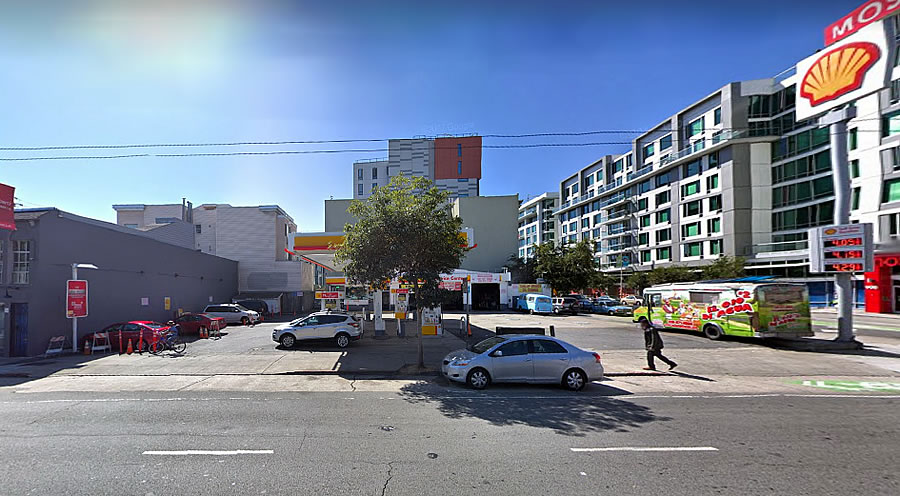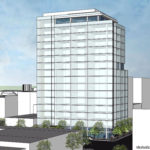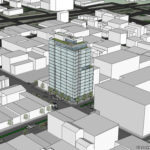While plans for an eight-story hotel to rise up to 85 feet in height upon the eastern three-quarters of the Central SoMa Shell Station site on the southwest corner of Fifth and Folsom were in the works, those plans appear to have been abandoned.
At the same time, plans for an even bigger development have been massed by TCA Architects for the Fifth and Folsom Investors LLC.
And as newly envisioned, a 16-story building would rise up to 160 feet in height on the 300 5th Street site, with 130 apartments over 1,000 square feet of ground floor retail space and a request to waive the site’s existing 85-foot height limit – which wasn’t changed per San Francisco’s Central SoMa Plan – based on California’s Density Bonus Law.
We’ll keep you posted and plugged-in as the plans progress.



This is an appropriate height for all of SOMA. I hope this is successful and more developers leverage State Density Bonus to get appropriate density for this neighborhood.
Agree – live on the next block, and this is a perfect area for dense infill housing.
running low on gas stations in soma – at what point do they get to become legacy businesses?
All it does is force people in cars to drive farther to gas up. It’s not going to encourage the majority of new residents in the area to abandon cars for transit, biking or walking given how many of these developments have underground residential parking.
There are 5 gas stations in SoMa within a mile of each other. When they become a hot commodity again, developers will put them beneath housing or offices, as they do in other major cities…
Nope. Chargers in every garage.
That doesn’t seem like much of a burden considering SF is a small city. You can criss cross the whole city thirty times on a single tank of gas.
Any entrepreneur who sees a market opportunity for maintaining existing gas stations in San Francisco should purchase one, and if they can, profit from it. If you think that’s the best and highest use of the land, go for it. Outbid the homebuilders who understand that we need more homes near jobs, and are ready to risk their money to purchase a gas station, shut it down, and build homes on the site.
But you might want to think twice before you risk your money. Many homebuilders have noticed that because we’ve built so few homes near the growing number of jobs in San Francisco and on the peninsula, many people have been pushed into long, gas-guzzling commutes to outlying areas. Many of those people would rather live near their jobs, and that demand for housing near jobs has been reflected by the sharp increase in rents in recent years.
By contrast, gasoline consumption in California peaked in 2005 at 15.9 billion gallons. Since then, California’s population has grown from 36 million to 40 million people. Yet despite a 10% increase in population, gasoline consumption dropped to 15.6 billion gallons by 2018. That’s according to the data on net taxable gasoline sales compiled by the State Board of Equalization.
Gasoline stations are being replaced in San Francisco by higher and better land uses, in part because demand for gasoline is declining, and in part because demand for more needed uses – like homes – has risen.
Lastly, no serious transportation or environmental agencies, nonprofits, or academic researchers think that maintaining those gasoline stations will help reduce vehicle miles traveled or gasoline use, because no evidence exists to support that claim. Or am I overlooking something? If you’ve got real evidence, present it.
Car ownership is dwindling in the city, and there are still many gas stations in soma. Dense downtown areas don’t need to accommodate huge numbers of gas stations just for rideshares and taxis, and we’re living in a time where the vast majority of cars will be electric in the next few decades. Soma’s remaining gas stations will disappear appropriately with dwindling demand.
Roughly 365,000 cars were registered in San Francisco in the year 2000, representing one car per 2.13 people living in the city at the time. Registrations totaled nearly 408,000 in 2015, or one car per 2.12 persons with the population having grown by 89K. And last year, 409,000 cars were registered in San Francisco, or roughly one car per 2.16 people in the city as of the beginning of this year.
In other words, while the ownership rate has “dwindled” by a little over 1 percent, in total, over the past 18 years, there are now 44,000 more cars registered in the city.
I’m all for dwindling combustion and expanding electric as fast as possible. And, for closing this horrible station. And for the 16 story development.
However, the crucial place to maintain a few gas stations in SF is Soma. This is the neighborhood that pours untold thousands of cars onto the freeways every day. The last thing we need at rush hour is cars driving randomly around Soma looking for gas.
Think of the poor drivers! Unable to revise their behavior patterns… or look at a map!
Maybe it’s time to close some of those SoMa freeway ramps too, as it increasingly becomes a dense, livable neighborhood. We’ll probably be tearing down much of 280 in the coming decades anyway!
280 will not be torn down. It is much needed. Elevated freeways are better as less direct conflict with cars and other modes
The 280 spur is a literal dead end. It’s not vital in any way, shape, or form.
Definitely [not] dwindling. SF is reasonably car friendly and public transit is 3rd world
This shell station brought so much crime during Covid good riddance now is the time yo the city to deploy charging station for all parking space on the street
Bring it! soma needs people and housing to calm the antiquated auto oriented buildings and uses.
So, are the plans for a separate residential building on the westernmost one-quarter of the property (fronting Folsom) still in play?
Yes, as included in the massings above.
I’m all for going taller in the Central SOMA if, the key, the taller buildings have a smaller footprint. Allowing for open space, mini-plazas, alleyways and engaging streetscape. This proposal simply replaces an 8 story wall to wall blockbuster with a 16 story such. .If that is the choice then keep the Central SOMA 85 foot height caps.
I agree, but it doesn’t seem to be in the cards. Just the opposite. Look how Trinity addresses the streets ape. Engaging, it’s not. One of the structural problems of Soma is narrow sidewalks. It’s not like any of these streets can be turned into Paris boulevards. Another structural problem is those cars. My most recent walk down 9th street was almost frightening. Like breathing straight from an exhaust pipe. (Yah, eventually that will get better.)
In the old days, I drank coffee on the sidewalk in front of Brainwash. Folsom was a sleepy cow path then compared to now. It was nice.
Loved Brainwash and MACadam computers. To the old days of hanging out South of Market.
Agreed.
If anything, I think it’d be great to see the narrow(ish) lot widths maintained more often; even if the design only manages to suggest it.
Narrow lots are far more a part of the SF visual palette than the damned bay window thing the city forces on us.
Quite a few larger SOMA projects (if not the majority) have plazas, paseos, pocket parks, and alley rehab worked into their scope.
Just across the street, Mosso rehabbed/greened the alley, and opened up a pedestrian passage along the western lot line with benches, trees, and lights. 5M, a block north, has a ton of open space and pedestrian priority in their plan. 1140 Harrison also has a relatively large pedestrian passage (albeit gated) to help break up the massing.
That mid-block passage and mini-park Mosso added is absolutely lovely. A rare place of calm and refuge in SoMa.
Folsom is a 4 lane highway running through SOMA. Surely, SFMTA can do away with one lane to widen sidewalks on both sides. Assign whatever walkability score to SF neighborhood. Paint as many bike lines as you’d like. Cars still rule SF. Even when car ownership dwindles it will be replaced by ride sharing instead of unreliable public transportation (MUNI)
I totally agree with you that current conditions devote too much space to speeding cars and make it unpleasant. To that end, you may like the long-term Folsom-Howard Streetscape Project.
Folsom is already 3 lanes. It’s not going down to 2. The protected bike lanes and bulbouts are all well and good for improving safety. And, electric cars will at least improve the street level air quality. But there is nothing now, or in the works for the next 20+ years, that is going to change the character of Soma being a collection of slow-moving freeways with narrow sidewalks. And IMO the POPOS are not in any way enough to change that.
In fact, the Folsom-Howard Streetscape Project does propose to reduce Folsom’s general driving lanes to 2, along with a transit-only lane for Muni buses, a parking lane, and a protected bike lane. Since buses and bicycles take up less space per person, this change will increase, not decrease, Folsom’s capacity to move people.
I stand corrected. Do we hear 1? Uber pickups will take care of that, I guess.
That’s going to be really nice. Frankly, most of my concerns are for the north/south streets, and their function as avenues for entering/exiting the city.
UPDATE: The proposed development has been newly rendered, but Density Bonus Battle Lines Are Being Drawn.